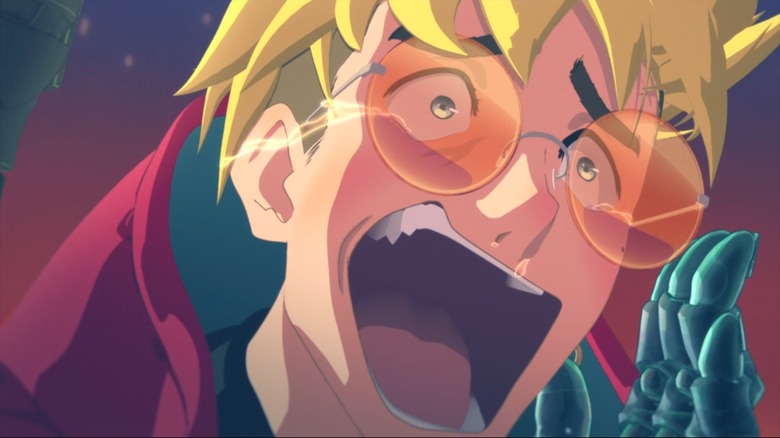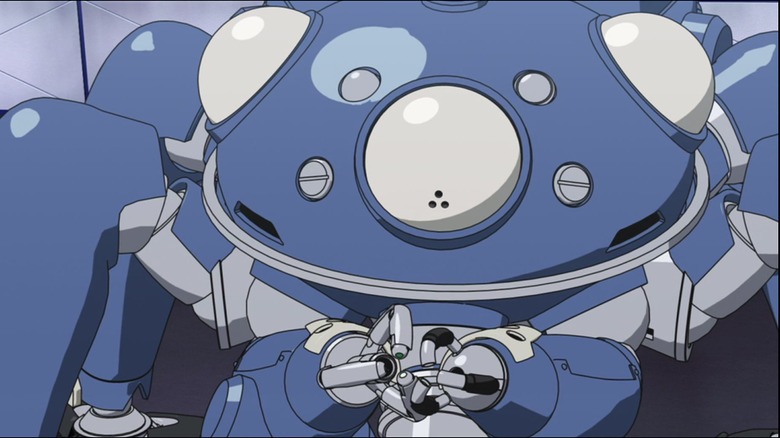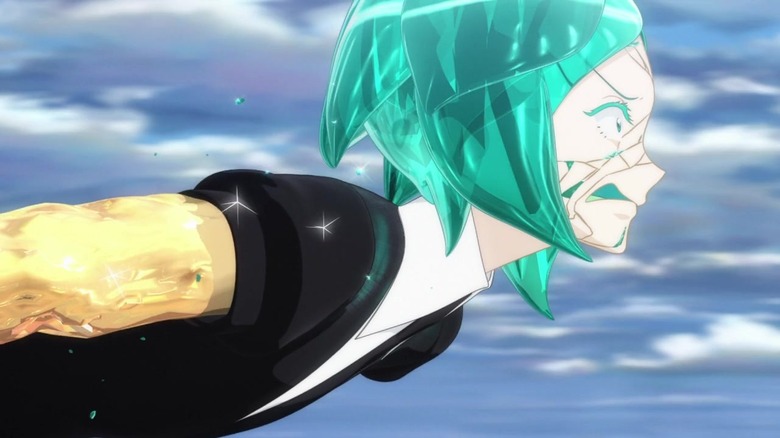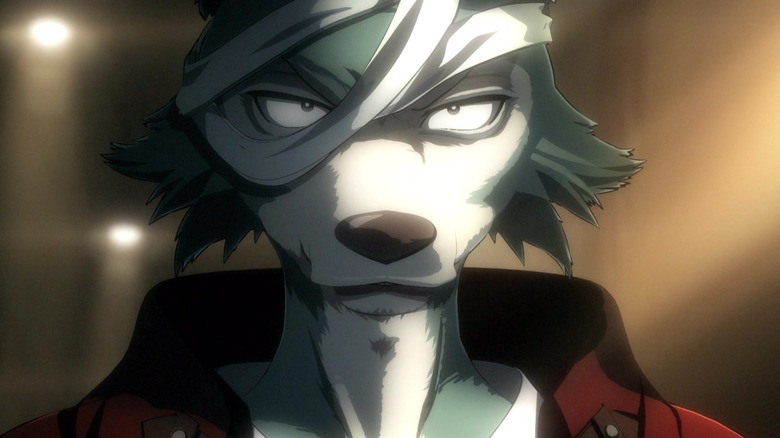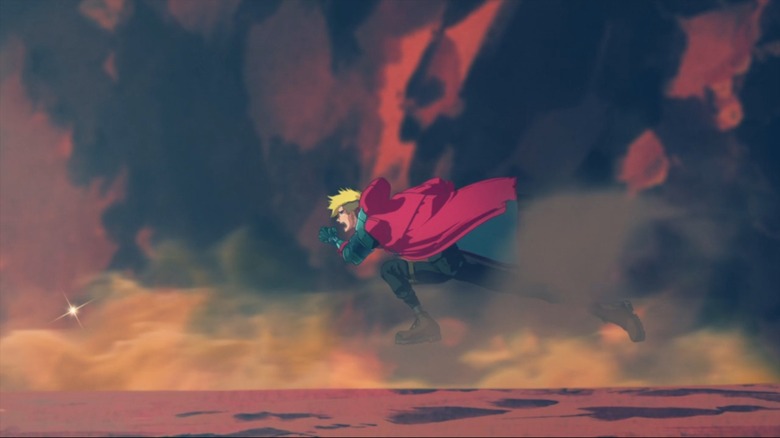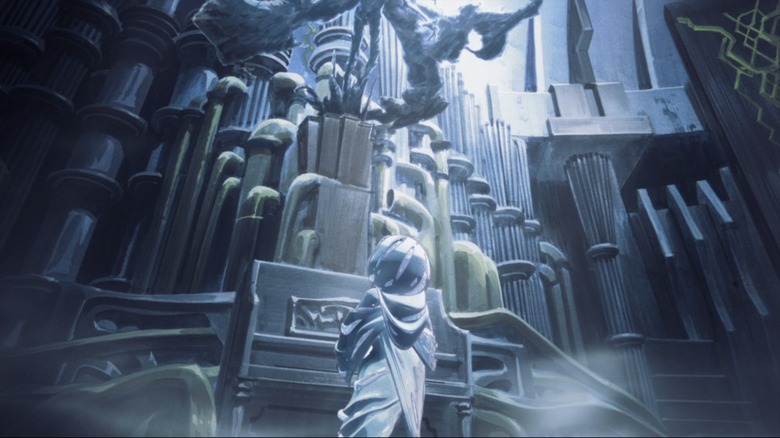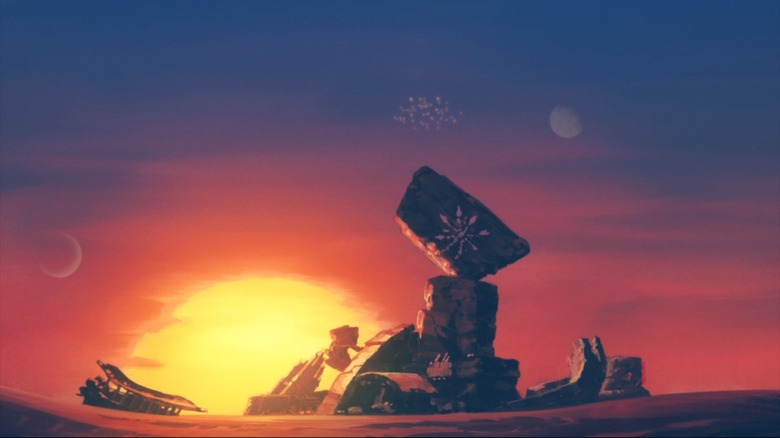How 3D Anime Specialists Studio Orange Created The World Of Trigun Stampede
"Trigun Stampede," which premiered in January on Crunchyroll, is an event. It arrives nearly a quarter of a century on from the original "Trigun" anime — it first aired in 1998 in Japan — that was based on Yasuhiro Nightow's original manga and its follow-up "Trigun Maximum." Following a DVD release in early 2000, it was screened on Adult Swim in 2003 alongside future classics like "The Big O" and "FLCL." While "Trigun" was fairly popular in Japan, it exploded in the U.S. Fans still look back fondly on the adventures of Vash, whose commitment to pacifism in the face of violent struggle may stem from Nightow's experiences with Christianity. While the 2010 film "Trigun: Badlands Rumble" kept the flame alive, it didn't add much new to the franchise. "Stampede" is different, as it draws on elements of "Maximum" that never made it into the original anime, to remix the "Trigun" experience for a new audience.
Honestly, though, I could care less about "Trigun." I never saw the original series when it aired, and the source manga put me off with its famously convoluted paneling. What I do care about is Orange, the studio behind "Trigun Stampede." Orange is one of the best computer-graphics (CG) studios in Japan, famous for acclaimed adaptations such as "Beastars" and "Land of the Lustrous." Sure, other CG studios are similarly ambitious — Polygon Pictures has steadily been improving over the past decade, while Graphinica has done great work together with Studio Trigger on the "Gridman" franchise. But only Orange has consistently made CG series that have satisfied the notoriously finicky fans of 2D anime. "Trigun Stampede" is their most ambitious work yet, drawing on everything they have learned since the studio's founding in 2004.
Eiji Inomoto against the world
The Orange approach distinguishes itself from Japanese 3D CG animation in a few respects. First is its attention to framerate. 3D CG often runs at a consistent framerate of 24 frames per second to ensure smooth motion. The likes of 2016's "Bubuki Buranki" experimented with lowering the framerate to emulate the snappy poses of anime, with inconsistent results. But Orange's eventual founder Eiji Inomoto was experimenting with dropping the framerate years before that. In a look at "Beastars," Tokyo-based Australian YouTuber Callum May notes that Inomoto has been secretly dropping frames since 2002's "Zoids: Chaotic Century." Inomoto did so despite warnings from his superiors, who believed smoothness was the ideal for CG animation. But Inomoto believed that in the right circumstances, lowering the framerate simply looked better.
Inomoto would go on to become one of the most talented CG animators in the industry. According to May's video on "Land of the Lustrous," Inomoto headed the Tachikoma 3D unit in 2004's fan-favorite "Ghost in the Shell: Stand Alone Complex 2nd GIG." That the Tachikomas — spider-like robots with cute personalities — are one of the series' most memorable aspects is partly due to Inomoto and his team. Years later, now at Orange, Inomoto helped elevate the giant robot duels of the otherwise perfectly fine "Majestic Prince" into some of the best action to air in 2013. Orange could have coasted on its reputation as a support studio able to overshadow its partners through 3D expertise. Instead, they released their very first TV series in 2017 — an adaptation of the manga "Land of the Lustrous."
Uncut Gems
Following its release, "Land of the Lustrous" became a benchmark for 3D CG anime on television. Its use of the camera and a variable framerate inspired the crew of "Spider-Man: Into the Spider-Verse," the groundbreaking Oscar-winning animated film. Recent successes like "Puss in Boots: The Last Wish" owe their deliberately choppy action sequences to what Orange pulled off six years ago. Of course, Orange themselves took inspiration from animators in the U.S. Per Callum May, Eiji Inomoto and his team were inspired by Disney's 2010 film "Tangled," in which legendary animator Glen Keane drew over 3D models in 2D to fully capture the expressions of characters. Orange would take this lesson forward by utilizing 2D animation to supplement 3D throughout the making of "Land of the Lustrous." According to Kevin Cirugeda, (via Sakuga Blog) "right about any close-up, especially those that need to depict nuance, is actually a 2D drawing."
Orange's work on "Land of the Lustrous" represents the best of both 2D and 3D approaches. Its action sequences utilize the camera in ways that would be impossible in 2D anime. The design of the Gems, whose hair reflects light based on complex simulation, similarly makes full use of the potential of computer animation. At the same time, character expressions are either aided or replaced by 2D. Former Studio Ghibli background artist Youichi Nishikawa drew concept art for the series that defined its mesmerizing world. The show's most harrowing scene, in which the protagonist Phos tries and fails to save her friend Antarcticite, benefited from over 200 cuts drawn by legendary animator Norio Matsumoto as "pre-visualization footage." This was combined with Orange's 3D work to make the sequence even better than the sum of its parts.
Wolf like me
Orange's next anime adaptation, 2019's "Beastars," built on the accomplishments of "Land of the Lustrous." Nao Otsu, who had handled sub-character design on "Lustrous," was promoted to character designer to ensure the source comic's expressive faces were done justice in 3D CG. Voice acting was (once again) pre-recorded to serve as a guide for the animators — in fact, it was even more important this time since "Beastars" is an unabashed theatrical drama. The crew at Orange used facial motion capture to build a library of believably human facial expressions and then mapped them to the faces of the show's animal characters. They also made careful use of lighting and shaders to ensure each character's fur looked good from every angle. Like with "Land of the Lustrous," Orange could not hope to literally replicate the appeal of "Beastars." But they could at least make something that captured its essence.
"Beastars" also benefited from Orange's willingness to think outside the box of traditional anime techniques. The first season's opening credits, a lovely stop-motion dance sequence made by Dwarf Animation Studio, was the best possible advertisement for the show's priorities. The seventh episode features an incredible dream sequence drawn by Yoko Kuno, an award-winning animator and manga artist. Kuno was previously involved with "Land of the Lustrous," where she contributed episode direction as well as a memorable 2D ending sequence. As "Trigun Stampede" producer Yoshihiro Watanabe said in an interview with Crunchyroll, "we don't try to limit ourselves ... to producing one medium." Any style that might lend itself to the goals of the production is fair game, as long as it's deployed in the right context.
The road to Trigun Stampede
That brings us to "Trigun Stampede," the most ambitious Orange production so far. It's the first full-length series by the studio to feature human characters rendered in 3D CG. "Stampede" borrows from both the original 1998 anime adaptation as well as the "Maximum" manga, but is not limited to them. Yoshihiro Watanabe revealed that sci-fi writer Takehiko Oxi was brought on board to draft the "story concept" in pre-production. Koji Tajima came up with character designs and a sea of concept art to define the look and feel of the series. The results capture the brashness of the source material but diverge in key ways. Vash's fated nemesis Knives has a penchant for dramatic piano playing. Series heroine Meryl is a journalist instead of an insurance agent. Controversially, her friend Milly is nowhere to be found.
"Stampede" draws upon every project in Orange's history. Variable framerate, and integration of 2D and 3D animation, were essential to the success of "Land of the Lustrous." So was the animation of hair in "Beastars," as well as the show's improved 3D facial expressions. These qualities are visible in "Stampede."
At the same time, the studio's smaller projects did just as much to pave the way. Orange's original short "Sun Shower" trained them in animating expressive smoke and rain, skills that would be needed for the desert world of "Trigun." The studio's music video for the mobile rhythm game Idolish7, "Mr. Affection," taught the animators how to animate cloth in CG separate from the bodies of characters. "Godzilla Singular Point," Orange's collaboration with 2D anime studio Bones, featured giant "kaiju" creatures of the like that appear in "Stampede." Nailing texture and weight, and ensuring Godzilla and his peers moved similarly to their appearances in film, were essential to the project.
Old friends return
One of the most important stops on the road to "Trigun Stampede" was "Home," a sci-fi short film. Up to this point, Orange had situated its 3D characters in appealing 2D environments. Per the studio, it faced "difficulties tackling the challenge to create fully 3D backgrounds." With "Home," Orange aimed to create proper 3D environments for the characters to navigate. The surface of Mars was animated in 3D to allow for a sense of planet-sized depth and scale. When it came time for "Stampede," the studio used Unreal Engine to structure the town of Jeneora Rock for use in layouts and backgrounds. Vash's antics could now be captured in full 3D, rather than having to rely on 2D as a crutch.
Again, past studio talent was tapped to ensure "Stampede" would live up to its ambitions. Nao Otsu returned to render character expressions in 2D and ensure they translate to 3D without any hiccups. It's no exaggeration to say that the characters in "Stampede" are some of the liveliest and most cartoony of any CG production released on TV, enough to embarrass competing shows such as "Kaina of the Great Snow Sea." Another familiar face appears from "Land of the Lustrous," as Kenji Mutou makes his directorial debut. Mutou storyboarded and directed some of the best episodes of "Lustrous," distinguishing himself among the likes of Yoko Kuno and series director Takahiko Kyogoku. "Stampede" demonstrates his flair for the dramatic, from Vash's early "gunfight" in the first episode to Knives's apocalyptic assault on Jeneora Rock in the third.
The real thing
Were it not for the years of hard work put in by Orange to lay the foundation, "Trigun Stampede" wouldn't exist. But does any of this matter to a casual viewer? Is it worth memorizing the many names behind and practices of the studio's history to better understand what "Stampede" is doing? I think it depends on your interests. To me, there's real drama in the story of Orange founder Eiji Inomoto, who has been fighting the biases of the public and his bosses against CG animation for two decades now. "He's been through more than anything I have seen," Yoshihiro Watanabe said, "but [he] continues in what he believes in." Similarly, it's fun to root for up-and-coming artists like Kenji Muto or to seek out the back catalog of freelancers like Yoko Kuno.
At the same time, Watanabe has noted, you don't need to know any of this to enjoy "Trigun Stampede." He told Crunchyroll: "If you see it, and you enjoy it, then that's what the real thing is. The emotion that you're feeling as you're watching the episode" is what is most important.
Animation — just like live-action film — is an illusion, a magic trick. Studying the lives and techniques of magicians can be fun in its own right, and teach you something about what it takes to push the boundaries of the medium. But while Orange has been generous in providing behind-the-scenes insight into the making of its newest series, "Trigun Stampede" speaks for itself.
